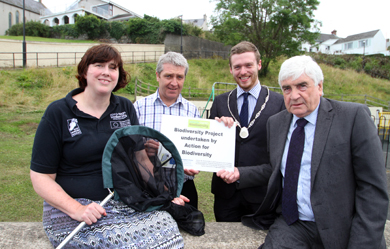 Abbey McSherry, Action for Biodiversity, with DJ Morgan, Down Dostrict Council Parks Officer, Vice Chairperson Gareth Sharvin and Ardglass Councillor Dermot Curran att the site where the wildflowers are being planted adjacent to the play area in Quay Street, Ardglass.[/caption]
Abbey McSherry, Action for Biodiversity, with DJ Morgan, Down Dostrict Council Parks Officer, Vice Chairperson Gareth Sharvin and Ardglass Councillor Dermot Curran att the site where the wildflowers are being planted adjacent to the play area in Quay Street, Ardglass.[/caption]
BEES and butterflies are giving a big “antennas up” for the Bee Feast project in Down District this year.
Areas in the district were selected for management and planting to encourage nectar loving insects such as bees and butterflies.
At Roughal Park in Downpatrick, a high colour mix of butterfly, bird and bee attracting flowers along with some meadow grasses and a selection of traditional cornfield annuals were planted for a beautiful flower bed that has buzzed with life during recent hot weather.
In Newcastle a larger area has been set aside at Island Park for a wildflower meadow consisting of cornfield annuals, fine leaved grasses and native perennials which will provide a range of flowers of different types over at least four years.
Speaking at a recent meeting in Ardglass, Down District Council Vice-chairman, Coincillor Gareth Sharvin said: “The final ‘Bee Feast’ project was a more ambitious one and has really shown that managing land for biodiversity can please the wildlife and also be easier to look after than a green desert that makes up much of the district’s amenity grassland. The steep slope above the playpark in Quay Street in Ardglass has caused management problems over the years, as it is almost impossible to cut the grass safely at this site due to the steep gradient particularly in wet weather.”
“However this change of management will take a few years to bed in and really show its results. In autumn last year some 42,000 bulbs of simple narcissus, grape hyacinths, spring crocus various aliums, crocosmias and autumn crocus were planted across the slopes.
” This mix is designed to provide bee friendly flowers rich in nectar and pollen which bees can easily access from early spring to late summer providing a good supply of pollen at the critical times through the year. The ‘Bee Feast’ project is an example of the work Down District Council is delivering to protect and nurture the wildlife we live with every day.”
Ardglass Councillor, Dermot Curran further added: “Additional planting of other wildflower species will also be added to the bank in coming years to increase the biodiversity and beauty of this area. Instead of being cut five or six times during the summer season producing a sterile and uninteresting grass slope the bank will be cut in the autumn after all the bulbs have finished flowering assuring an ever changing display of lovely flowers for Down District residents be they human or insect. I look forward to seeing a further addition to wildflower garden which will reflect the landscape of our fishing village.”
Bee Feast in Down District is part of the regional project ‘Marvellous Meadows and Bumbling Bees’ that Action for Biodiversity is undertaking across the ten local authority areas of the East Border Region.
This initiative is part of the Action for Biodiversity Project which is part funded by the European Union’s Regional Development fund through the INTERREG IVA cross border programme.
]]>























